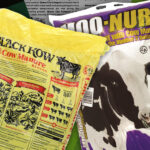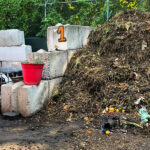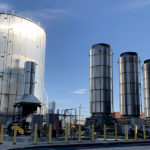Top: The new composting system at the County of Santa Barbara (CA) ReSource Center has capacity to process 300 tons/day of digestate. Photo courtesy of Sustainable Generation®
The Santa Barbara County (CA) ReSource Center includes mixed waste and single-stream recycling processing, an anaerobic digetion facility (ADF) and a composting system for the digestate. The Center has capacity to process 550 to 600 tons/day of mixed municipal solid waste, which yields organic fines, recyclables and residuals that are landfilled. The organics fraction (250-350 tons/day) is anaerobically digested for 28 days in bunkers, and then is composted. The ADF also receives about 3,000 tons/year of source separated organics from commercial generators. The ADF, which began operating in 2021, is undergoing renovations and is not operating at full capacity. The original composting site utilized windrows, which became an odor source earlier on in the facility’s operations. Managing litter and storm water were also challenges, along with compost quality.
To address the odors, the County initiated a pilot study to compare aerated static pile composting (ASP) with the existing windrow method. “We tested the SG MOBILE® System with GORE® Covers and an ECS uncovered ASP system using different feedstocks,” explains Carlyle Johnston, Project Leader, Public Works Department, Resource Recovery & Waste Management Division, County of Santa Barbara. “We ultimately were going to need a covered operation to control litter due to high winds and rainwater coming into direct contact with the piles. Because the SG system is completely encapsulated, it met the criteria we were seeking.”
The pilot was conducted for nine months, starting in February 2023. “Within 90 days from setup to tear down, Sustainable Generation® (SG) performed multiple batch tests to determine the proper mix recipe and prove that the SG MOBILE® System would eliminate odors, which included a third-party independent test for odors and VOC emission reduction compared to the existing open windrow process,” says Scott Woods, SG’s CEO. “The pilot demonstrated 97.5% odor reduction, 98% VOC emissions control, clear separation of storm water from leachate during adverse weather events — including atmospheric rivers from the Pacific Ocean, meeting PFRP temperatures (3 days at 131°F), and production of a stable and mature final compost.”
The county selected Sustainable Generation to build a 300 tons/day, 20-heap system, which began operating in February 2024. All active composting and curing take place under the covers. On grade pipes are covered with mulched green waste, and then digestate is added. “The $4 million investment has made composting more consistent,” notes Johnston. “The system made sense on a lot of levels. It will be a while before the ADF is fully operational, at which point the composting facility will be more fully utilized. Santa Barbara is an agricultural county, and there is certainly a lot of interest in the finished compost from growers.”













